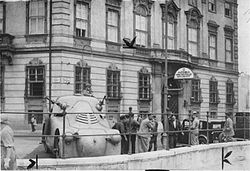
Back انقلاب يوليو Arabic Červencový puč Czech Juliputsch German Golpe de Estado de julio (Austria) Spanish Putsch de juillet French Golpe de Estado de xullo (Austria) Galician פוטש יולי HE Upaya kudeta Juli ID Putsch di luglio Italian Juliputsch Dutch
| July Putsch | |||||||
|---|---|---|---|---|---|---|---|
| Part of the interwar period | |||||||
 Police car at Ballhausplatz outside Chancellery building, 25 July 1934 | |||||||
| |||||||
| Belligerents | |||||||
|
Supported by: |
Supported by: | ||||||
| Commanders and leaders | |||||||
|
Fridolin Glass Otto Wächter Anton Rintelen |
Engelbert Dollfuss † Wilhelm Miklas Kurt Schuschnigg Ernst Rüdiger Starhemberg Emil Fey | ||||||
| Strength | |||||||
|
154 SS (Vienna) thousands (elsewhere) | Entire Federal Army, police, gendarmeries, and paramilitary Heimwehr forces | ||||||
| Casualties and losses | |||||||
|
98[1]–140[2] killed 13 executed[2] 4,000 detained[2] | 101[1]–104[2] killed | ||||||
| 11[1]–13[2] civilians killed | |||||||
The July Putsch was a failed coup attempt against the Austrofascist regime by Austrian Nazis from 25 to 30 July 1934.
Just a few months after the Austrian Civil War, Austrian Nazis and German SS soldiers attacked the Chancellery in Vienna in an attempt to depose the ruling Fatherland Front government under Engelbert Dollfuss in favor of replacing it with a pro-Nazi government under Anton Rintelen of the Christian Social Party. The Nazi putsch ultimately failed as the majority of the Austrian population and army remained loyal to the government. The Nazis managed to kill Dollfuss, but Kurt Schuschnigg succeeded him and the Austrofascist regime remained in power.
A German invasion of Austria in support of the July Putsch was averted due to the guarantee of independence and diplomatic support that Austria received from Fascist Italy. The Austrian government eventually suppressed the coup, with over 200 people being killed in six days of fighting.